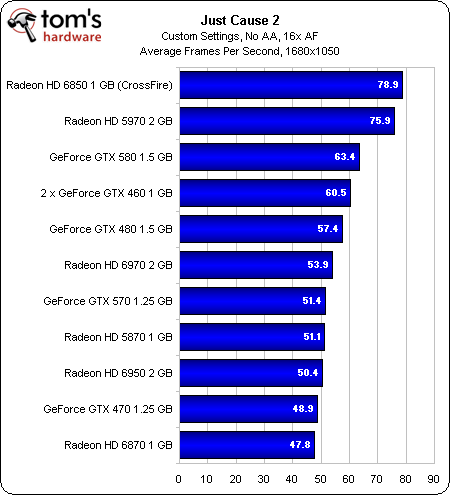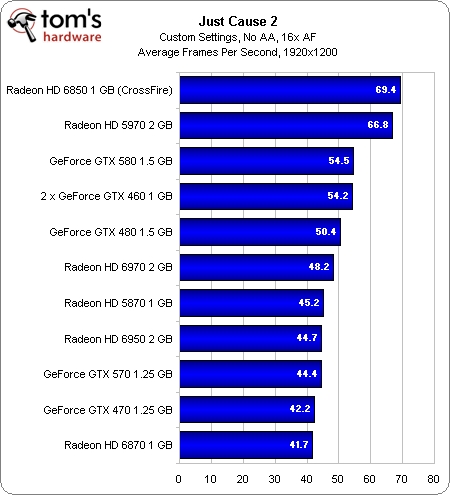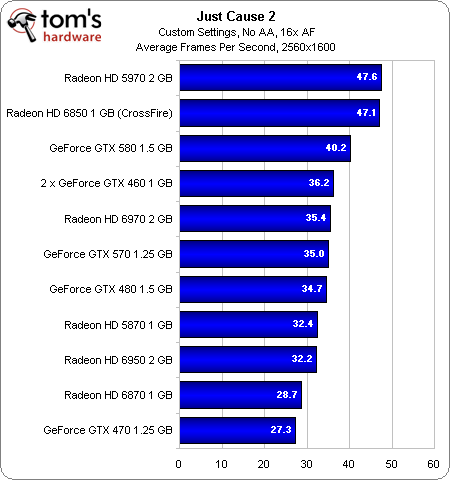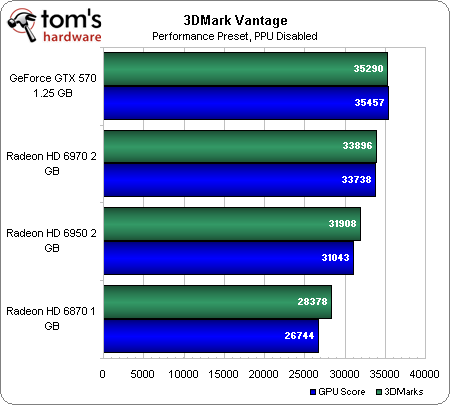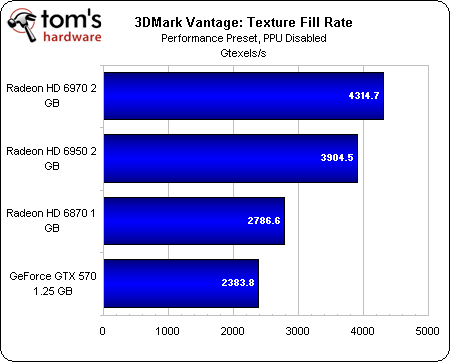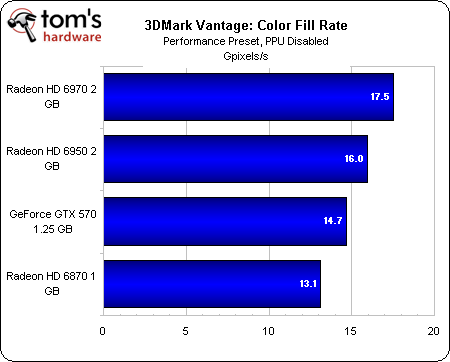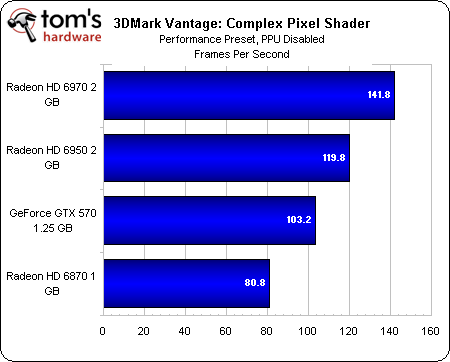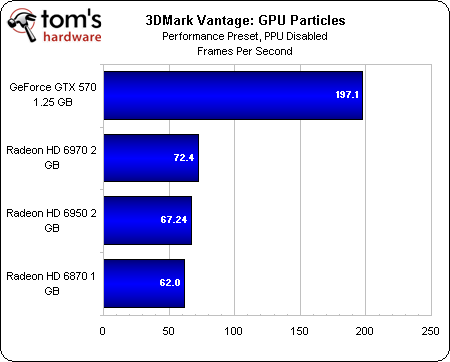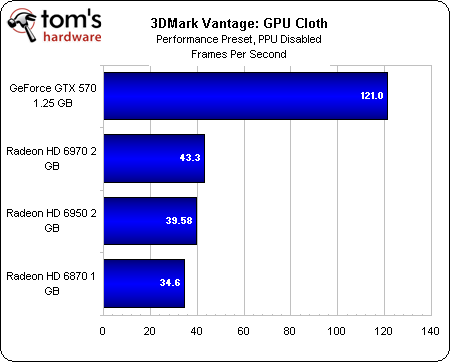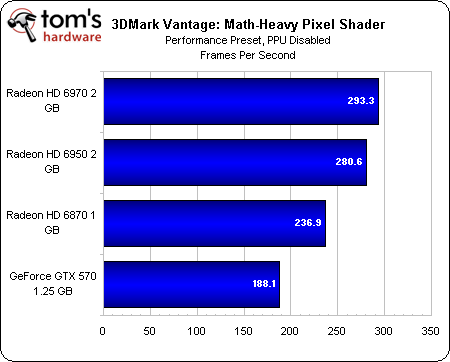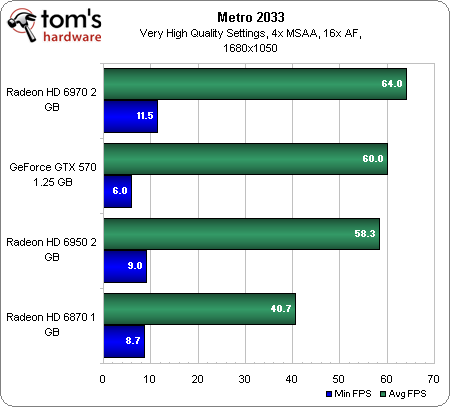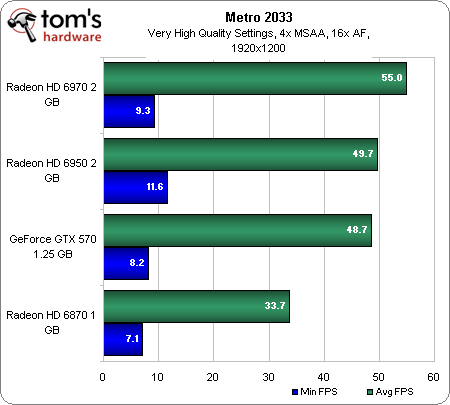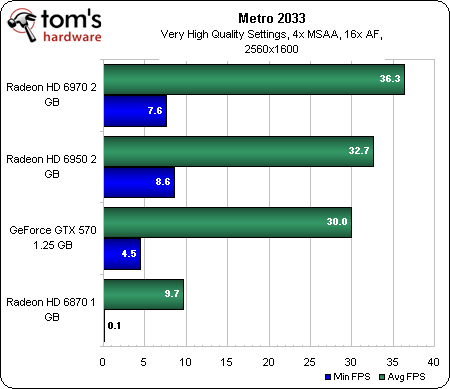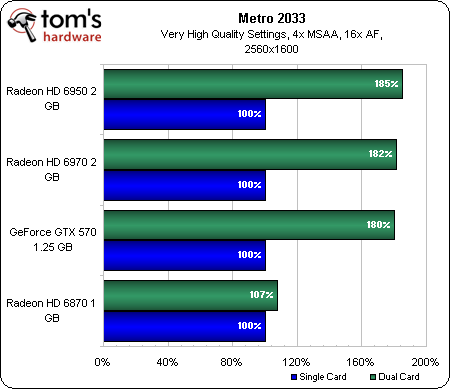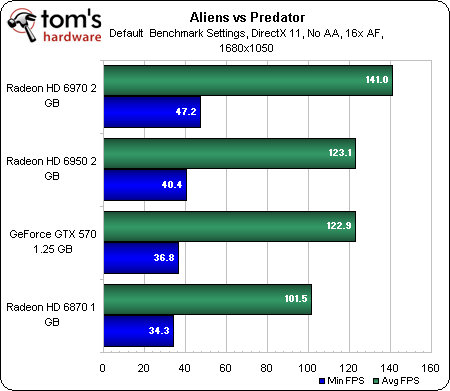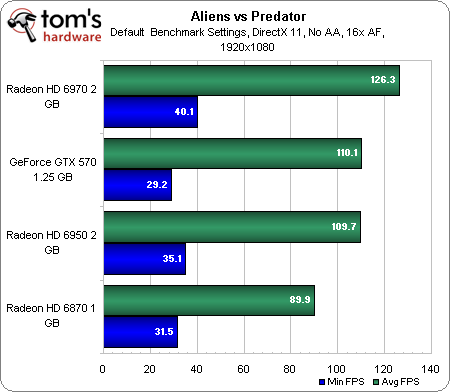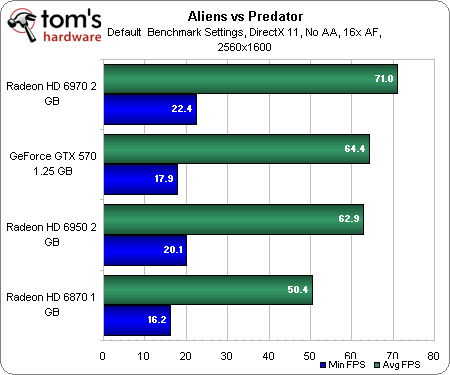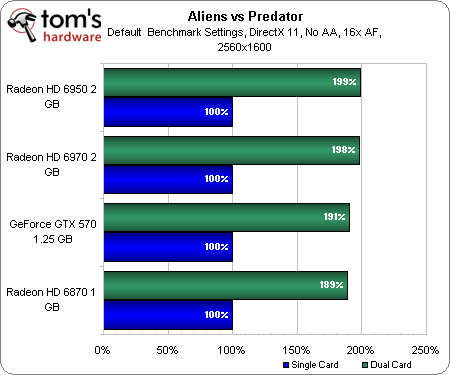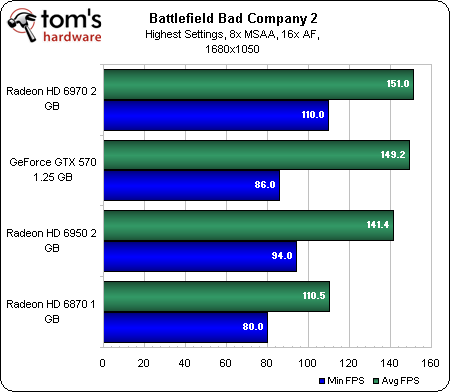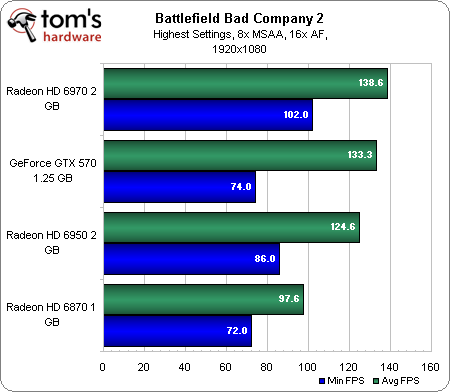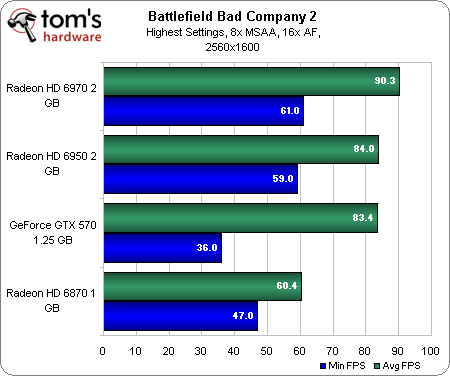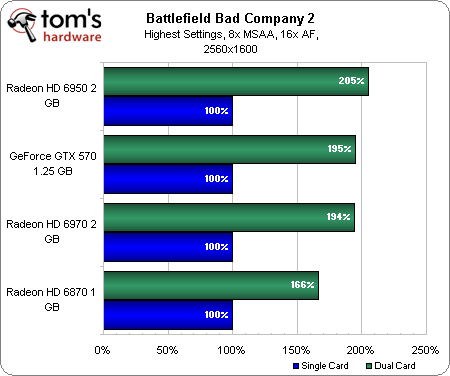|
TopNax |
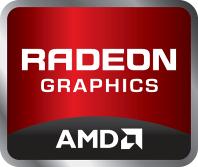
Benchmark Results: Just Cause 2 (DX11) |
|
The only real outstanding performers in Just Cause 2 are the Radeon HD 5970 ($500) and the CrossFire’d Radeon HD 6850s ($380). The better choice is obvious in this case, so long as you’re willing to set aside four slots worth of expansion for the two dual-slot cards. Nvidia’s GeForce GTX 580 ($510) is generally the next-fastest option, but again, you can save more than $100 if you go with two GeForce GTX 460 1 GB cards for $400 or so. From there, we see AMD’s new Radeon HD 6970 taking a middle-of-the-pack finish, trading blows with GeForce GTX 480 and GeForce GTX 570. Compared to the GTX 480s, which are still way overpriced and should be avoided at all costs, that’s not bad. However, AMD has serious competition in the GeForce GTX 570 selling for $350. Moving on down the stack, AMD’s Radeon HD 6950 roughly matches the Radeon HD 5870 currently selling for $290, giving the company a fairly round target in its own stack to beat. |
Multi-Card Scaling In 3DMark |
|
Doubling up in CrossFire and SLI, Nvidia's GeForce GTX 570 comes out on top, followed by the 6900-series boards, which soundly trounce the Radeon HD 6870 in CrossFire. Will these results map over to real-world games? Surprisingly (or maybe not), they don't.
|
Multi-Card Scaling In Metro 2033 |
|
Before we delve too deeply into analysis, let’s talk pricing. For every gap between individual boards, double that when you consider an SLI- or CrossFire-based configuration. That makes it particularly difficult to draw even comparisons. With that said, two GeForce GTX 570s are going to run you a staggering $700. A pair of Radeon HD 6870s go for $480. And if AMD's initial launch pricing plays out on the market, you’re looking at somewhere close to $600 for two 2 GB Radeon HD 6950s and roughly $740 for the 6970s. At 1680x1050, the Radeon HD 6950s nearly match Nvidia’s more expensive GeForce GTX 570s. The 6970s are faster still, though decidedly not fast enough to justify the hefty price premium you’d pay in excess of the GeForce GTX 570s or Radeon HD 6950s. After all, they don't exactly allow you to step up to a higher resolution than either of the less expensive solutions. Shifting over to 1920x1200, the 6950s manage to upset the GeForce GTX 570s, in part due to the cards’ larger frame buffers. The gap grows by a frame at 2560x1600, though by this point we’re decidedly no longer getting playable performance. For the sake of gauging the scaling of this demanding title, we re-ran our benchmarks using a single card at Very High quality settings, 4x MSAA, and 16x AF:
Clearly the Radeon HD 6870’s 1 GB frame buffer prevents it from realizing more than a small bump in performance here. The other cards do wield enough memory to make Metro 2033 a somewhat smoother experience at 2560x1600 and Very High quality settings, though. The real shocker is that both of the 6900-series cards realize better scaling that Nvidia’s GeForce GTX 570 in SLI. We explicitly talked to AMD about CrossFire scaling after its press briefing. According to the company, it didn’t make any changes to the Radeon HD 6800 series that would have improved its CrossFire scaling versus the Radeon HD 5870, as many folks suggested in our 6800-series launch coverage. It did, however, incorporate driver-based enhancements that augment CrossFire performance in the 6900 series. This seems to be reflected in the results here. Now AMD says that the 6800s will get the CrossFire-oriented improvements in a future driver update. For now, though, 5800-series and 6800-series cards should scale comparably, with the 6900s doing even better. |
Multi-Card Scaling In AvP |
|
Aliens Vs. Predator isn’t as demanding as Metro 2033, and at 2560x1600, it doesn’t use as much frame buffer, so the Radeon HD 6870s are able to handle it more gracefully. With that said, the Radeon HD 6950s and GeForce GTX 570s are roughly on par here, with the Radeon HD 6970s demonstrating a reasonable lead. The 6870s trail behind, not surprisingly, but still deliver what we’d consider to be playable average frame rates at 2560x1600.
AMD’s boards reaffirm the company’s claims of improved CrossFire performance, serving up an almost perfect doubling of frame rate at 2560x1600. Nvidia gives us the solid SLI scaling we’ve come to expect, but it’s the Radeon HD 6950 and 6970 that show off the best numbers. The Radeon HD 6870 doesn’t do poorly here, but it clearly doesn’t have the driver optimizations tied in to the 6900-series cards. |
Multi-Card Scaling In Battlefield: Bad Company 2 |
|
In what is becoming a familiar story, the two Radeon HD 6970s claim first-place finishes in all three resolutions, with the 6950s and 570s trading places below. AMD’s Radeon HD 6870s in CrossFire serve up playable performance across the board, but they’re much slower than the other three configurations tested here.
I chose 2560x1600 as the best resolution to compare scaling performance because, if you’re spending $700 or $800 on graphics, you should probably be running a 30” screen or a trio of 23” displays in Eyefinity or Surround. The fact that we’re still seeing 80 and 90 frames per second on average at the highest settings Battlefield: Bad Company 2 offers at that resolution affirms just how much graphics muscle is at our disposal. The Radeon HD 6900-series cards handle it in stride. A pair of Radeon HD 6950s achieves what can only be described as idea scaling performance, while the 6970s fare just a tad worse than Nvidia’s GeForce GTX 570s. Meanwhile, the 1 GB Radeon HD 6870s put down less compelling numbers—most likely a result of that frame buffer inhibiting performance. |
